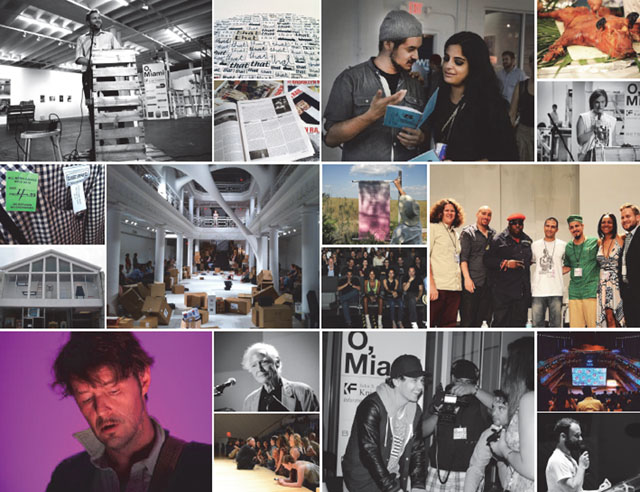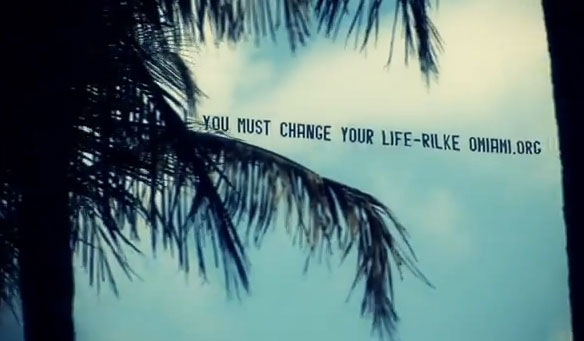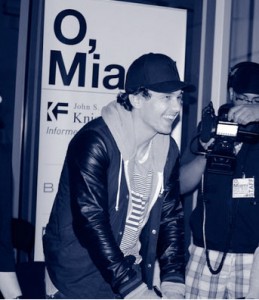
Up In The Sky! It’s A Bird, It’s A Plane, It’s Poetry!
The following is Part 3 of O, Miami: How a festival infused a city with poetry, an in depth look at the unorthodox event. Previously, Part 1 looked at the role of the festival in Miami’s growing art scene; Part 2 looked at building the festival.
The Ferrari said it all. If you were looking to make a dramatic statement that O, Miami was a very different kind of poetry festival — irreverent, playfully subversive, and not least, steeped in the often blindingly over-the-top spirit of South Florida — what better way than to put one of your featured poets behind the wheel of a gleaming red convertible Ferrari, hand him a bullhorn, and then have him literally proclaim his poems to the streets? Related Links
O, Miami: How a festival infused a city with poetry, an in depth report on the inaugural festival “I appreciate the typical wine-and-cheese poetry reading, but that’s so stale,” explains Dave Landsberger, the Ferrari-driving poet in question.
“Let the younger poets do younger, weirder things. Let the older poets do the more reverent things. There’s a place for both — and that’s why O, Miami was such a success.”
Landsberger certainly did his part to make a splash for the festival’s April 2011 debut, drawing a crowd as he double-parked his rented Ferrari alongside Lincoln Road, reading out one of his own poems, but only allowing himself to bask briefly in the resulting applause — he spotted a curious police officer approaching. From there he roared up to an impromptu reading in the parking lot of a North Miami Beach Wal-Mart, and then back to the drive-through window of a Biscayne Boulevard fast-food restaurant — where he made a new poetry devotee out of a Checkers employee with a performance of Robert Frost’s “Nothing Gold Can Stay.” “Victory!” he laughs.
Though family commitments forced Landsberger, a 2010 MFA graduate of Florida International University, to return to his native Chicago, he is scheming for a way to relocate to the sub-tropics – and not just to escape the snow.
“You can go to Miami, participate in the arts community, and really feel like something is happening,” Landsberger says. “You don’t feel like something is happening in Chicago — it’s already happened. You’re just adding to it. But in Miami, you’re getting in on the ground floor.”
Indeed, helping to nurture a sense of city-wide creative ferment, a palpable feeling that “something is happening,” may be O, Miami’s greatest achievement in its first year.
Tellingly, for out-of-town correspondents trying to get a handle on O, Miami’s offbeat take on all things poetry, the city of Miami featured as prominently in their stories as any of the festival’s actual programming. Which, in the eyes of both festival director P. Scott Cunningham and the sponsoring Knight Foundation, is precisely the point.
“What O, Miami brought to the picture was the realization of Miami’s cultural promise,” explains Knight VP/Arts Dennis Scholl.
“The fact that it was so well received says as much about the evolution of Miami’s arts scene as it does about O, Miami itself.”
This is more than just cheerleading on the part of the city’s boosters. Mitchell Kaplan, who co-founded the Miami Book Fair in 1984, recalls all too well the distance traveled since then. In his own fair’s early days, he met constant resistance while trying to book top-notch writers. He was after Pulitzer-winners; New York publishers heard the word Miami and instead suggested Kaplan showcase their diet book authors and exercise gurus. “No one thought there was an audience for serious literature here,” he sighs.
Dispelling that intellectual skepticism — at home as well as in Manhattan — didn’t happen overnight. Which makes Kaplan all the more impressed by O, Miami’s out-of-the-gate high profile. The secret to South Florida success? “You’ve got to make it an event!” Kaplan insists.
To be sure, Cunningham took a cue from Art Basel, whose positioning as a spectacle draws countless folks who rarely set foot inside Miami’s art museums. Cunningham went for a similar approach, largely eschewing traditional lecture-hall readings, instead hosting an at-times bewildering schedule of forty-three one-time-only events and twenty-six ongoing projects which stretched across the month of April. It may have been too much of a good thing.
“We did too many events,” admits Cunningham. “We were worried about spreading events too thin, that most folks would only be able to go to one big one — which is actually what happened.” For the bi-annual festival’s second edition in April 2013, Cunningham still plans to keep the overall length at a month, “but heavy at the ends. Most of the middle of the month will be project-based. Any event, no matter how successful, is still reaching a few hundred at best. And then it’s gone. Whereas the projects had much more traction online.”
Case in point: Both Poetry Ferrari and Poetry Tags, in which Miami artist Agustina Woodgate secretly sewed short poems inside clothing still hanging on the racks at thrift stores, were hardly intended to sway mass audiences. They made most of their poetry converts one or two bystanders at a time. Yet those two projects subsequently garnered more national — and international — attention than all of O, Miami’s other events combined. Woodgate credits the subsequent attention, from viral videos to a glowing write-up in England’s influential Guardian daily newspaper, with changing her career.
“There’s nothing better than a well-read poem,” says Cunningham.
“Readings need to be the anchor of the month. But at the same time, we want to cultivate an audience for the projects and make poetry come alive.”
So, in preparing for the next O, Miami, what are the lessons learned? What worked well? What needs to be tweaked? With $175,000 in financial support from Knight for 2013, how can the festival get the most “bang” — programming-wise and promotionally — for its “buck”?
In his original Knight grant proposal, Cunningham wrote of hoping to “reposition poetry as an interdisciplinary field,” one that would inject itself into the heart of Miami’s arts arena. He’s certainly well on his way to achieving that aim — twenty of the festival’s forty-three events were joint ventures with local arts institutions, a mutually beneficial arrangement in which each partner brought new audiences to the other. “The cross-pollination was really good,” says Wolfsonian-FIU Museum Director Cathy Leff. “It’s a model of how you can get people to work together under a big umbrella.” The Wolfsonian’s lecture on the language of radical design, delivered by its own curator (and part-time poet) Matthew Abess, not only drew a full house of 110, it was pegged to a museum exhibit of Futurist and Constructivist poetry. “It allowed us to show the relevance of our collection and how it can relate to other arts,” says Leff.
An event with two avant-garde Argentine poets at the Museum of Contemporary Art met with a similarly warm reception from that museum’s then-associate curator Ruba Katrib, who foresees O, Miami becoming a “glue” between local arts organizations.
One poetry fusion Cunningham is particularly proud of was O, Miami’s modern dance performances — Nox and Stax, which featured New York’s Merce Cunningham Dance Company and the celebrated poet Anne Carson. Though the pair didn’t come cheap. Even with its Design District performance space donated by landlord Craig Robins, the two events still required Knight to add an additional $55,000 to its original 2011 festival grant of $250,000. With only ninety-three attendees at Nox and eighty at Stacks, that works out to quite a sizable cost per head.
“If you look at it that way, the numbers will never add up,” Cunningham says. “Unless you’re doing Broadway, dance is never going to be [cost-effective].” But he sees both Nox and Stax as being stellar in caliber, and a vital ingredient in — as he wrote in his original proposal — helping Miami “to shake its identity as a place where world class cultural events don’t occur on a regular basis.”
Accordingly, for 2013 Cunningham intends to push harder for his more thematically “difficult” programming. Only sixty-three people turned out for “Poetry and Violence,” what he deems O, Miami’s best reading, and one that moved the audience to tears as poets Brian Turner, Jill McDonough, and Raúl Zurita discussed their experiences, respectively, fighting in Iraq, working with death-row prisoners and surviving torture at the hands of the Pinochet regime in Chile. The subject matter may initially seem like a tough sell. But Miami is a city which, all too sadly, is intimately familiar with the legacy of political violence — as several generations of exiles from Latin America and the Caribbean can attest. With the right promotion, the event’s turnout should’ve been standing room-only, a judgment Cunningham agrees with.
“We need to believe in our own programming,” he says. “We were afraid it wouldn’t reach a larger audience, so we didn’t try to reach a larger audience. And so it didn’t.”
By contrast, Cunningham holds up the example of a special edition of the New World Symphony’s “Inside The Music” series, which explored the intersection of classical composition and poetry. Despite being held on a Tuesday night, 510 people attended, the largest crowd the symphony had ever seen for the series — a feat Cunningham attributes to the Symphony’s excellent in-house marketing. It’s a symbiosis which has continued: An April 2012 Symphony performance also featured the New York-based poet Malachi Black — brought to Miami for a reading and week-long residence by Cunningham’s University of Wynwood.
In further evidence of continuing partnerships, Black’s lodging was provided by South Beach’s Betsy Hotel. Owned by the son of acclaimed poet Hyam Plutzik, the Betsy has begun regularly holding public poetry events with Cunningham, offering a space on Ocean Drive that is (in keeping with O, Miami’s branding) anything but staid.
James Franco
Of course, nothing helps marketing like the strategic deployment of a celebrity. Such was the thinking behind O, Miami’s booking of actor James Franco. On paper, it was an inspired move: Franco holds a unique position as an object of fascination to both Hollywood and the avant-garde precincts of the art world, simultaneously co-hosting the Academy Awards and filming his own experimental shorts, pursuing an MFA in art at Yale in between major studio movie shoots, and writing his own verse under the tutelage of one of poetry’s most respected names, Tony Hoagland. With his ability to titillate both the paparazzi and the literati, Franco’s Miami reading alongside Hoagland seemed tailor-made to the festival’s mission of enticing new crowds.
Alas, Franco’s plane was delayed by stormy weather, diverted to Orlando, and then further waylaid as airspace was shut down in Miami while President Obama flew in and out. By the time an exhausted Franco finally arrived, four hours past the event’s starting time, half the audience of 490 had left. In the meantime, O, Miami publicist Lisa Palley had been tasked with crowd control. It wasn’t pretty. “I had to deal with the mothers who brought their teenage daughters!” Palley laughs. “They were screaming at me!”
“It was a bummer,” Cunningham concedes, as well as a lesson in travel logistics. But despite the snafus, Cunningham says Hoagland made a host of new fans that night:
“I had so many people approach me afterwards and say ‘I’ve never read contemporary poetry, I only came because my girlfriend dragged me here to meet James Franco. But that was awesome!’ ”
The same dynamic played out online: As pro- and anti-Franco partisans dueled on Twitter and in newspaper article comments, the festival received a fresh wave of free publicity. The marketing take-away for 2013 is clear: Controversy isn’t necessarily a bad thing. And even if they’re late and do little more than politely sign books, booking a celeb works wonders.
Of course, it’s not enough to merely grab an audience’s attention. O, Miami then has to physically steer them to its events. In that respect, festival advisor Tom Healy pointed to the fest’s “too clever and not all that useful” website as a “symptom” of confused messaging: Hoping to get a quick overview of the festival? Or even plot out a schedule more than a day in advance? Good luck with that online.
Likewise, the scattered nature of O, Miami often left casual fans of a single event wondering how to follow-up.
“Our narrative was like opening a box of chocolates. Even if you find one you like, you don’t know where you can find it again,” Healy says. “If people ask ‘Where is the festival?’ there needs to be a place they can just walk into.” He hopes that, just as the Miami Beach Convention Center serves as a week-long physical center for Art Basel, the New World Center and its outdoor park can act as a home base for O, Miami.
Moreover, as much as he enjoys the accidental discoveries behind the fest’s projects, “you have to prep for these experiences.” Otherwise, it’s the veritable tree falling in the forest, he says. Case in point, the poetry banner flown across the sky above South Beach: “I introduced the poet laureate that afternoon, and no one in the audience even knew about it — and these were the most poetry-oriented people imaginable!”
Still, for all his emphasis on outreach, Healy says the tail should never wag the dog: “It’s a question of popularity versus purpose.” In fact, Cunningham argues there’s a ceiling to just how broad O, Miami’s appeal can be — at least if it’s going to be “world class.” Romero Britto may be Miami’s top-selling artist, but don’t expect Art Basel’s organizers to ever allow his critically-dismissed paintings inside their fair. Likewise, for all the rhetorical appeal of O, Miami’s stated mission of introducing all of Miami-Dade’s 2.5 million residents to a poem, Cunningham’s populist vision has its limits. By enforcing an aesthetic line, he believes “attendees of cultural events such as the Book Fair and Art Basel will have a new event to mark on their calendars.”
Which begs the larger question: Can O, Miami eventually super-charge the city’s literary scene the way Art Basel has kick-started its art scene? Should we anticipate a crush of poetry fans corralled before a velvet rope, trading gossip on the latest mogul to commission a six-figure personalized stanza?
“You’re never going to get dozens of private jets flying into Miami for a poetry festival,” Cunningham scoffs. “That’s fine. That’s not where the value comes from.”
Besides, argues Borscht film festival director Lucas Leyva, comparisons to Art Basel — or any other festival — are off the mark. “So many previous cultural events were defined by Miami trying to be New York,” Leyva says. “This city has its own weird personality, and it needs to have events and institutions which match that.” A Kendall-native and filmmaker in his own right, Leyva may be a decade younger than Cunningham, but he shares the same excitement over Miami’s inchoate artistic ferment.
“A new generation of Miamians is defined by a sense of looking forward and building something. We don’t know what it is yet,” Leyva says, “but defining that new cultural identity is what excites so many people down here now.” This report on the O, Miami poetry festival is part of Knight Foundation’s Reporter Analysis Series. It was written by Brett Sokol, the arts editor at Ocean Drive magazine. His writing on Miami’s cultural scene has also appeared in The New York Times, New York Magazine and Slate. Judy J. Miller, who oversaw Pulitzer Prize winning coverage while serving as managing editor of The Miami Herald, edited the report. For more on Knight Foundation, visit knightfoundation.org, and for more on the festival, visit omiami.org.

